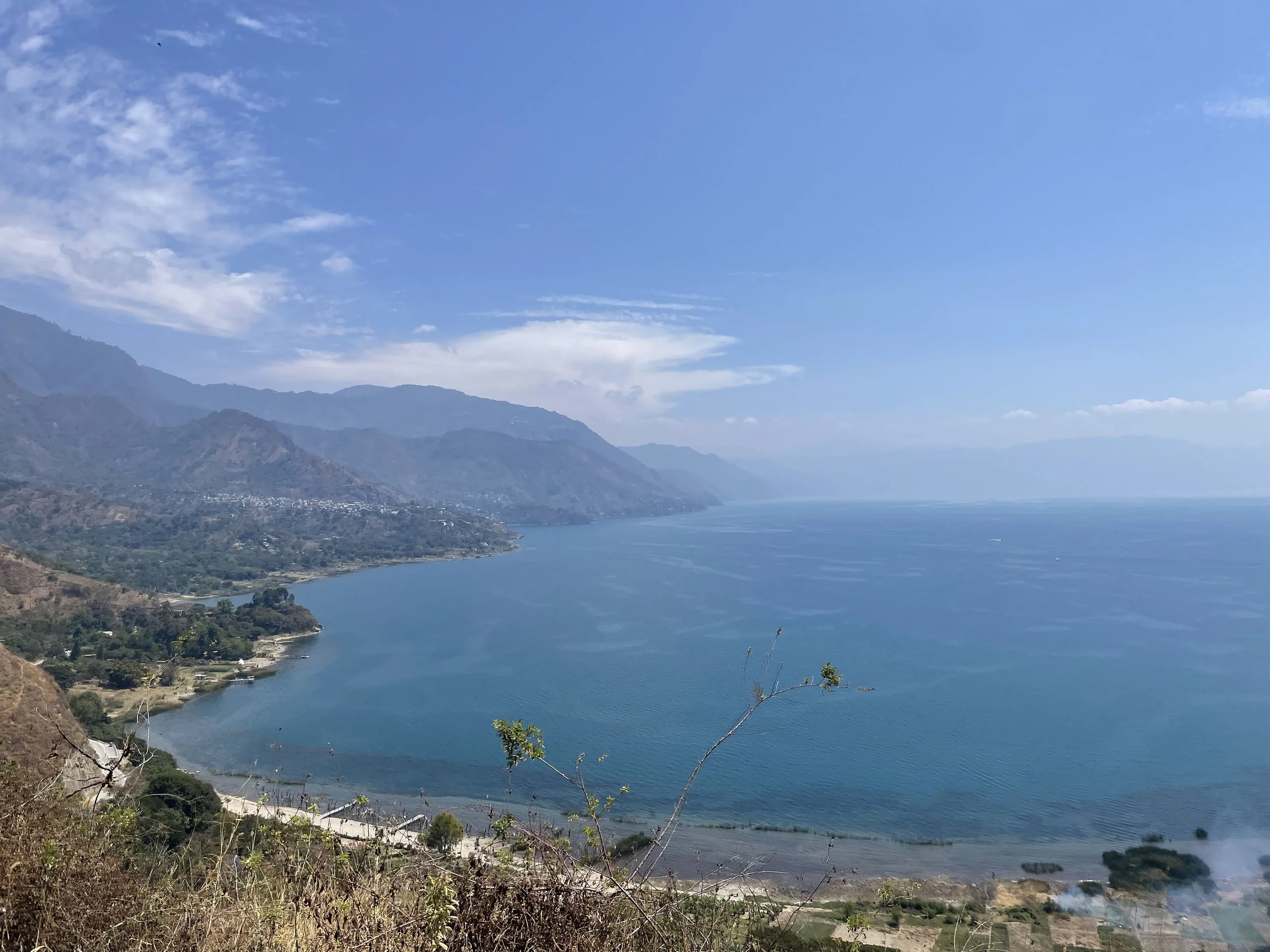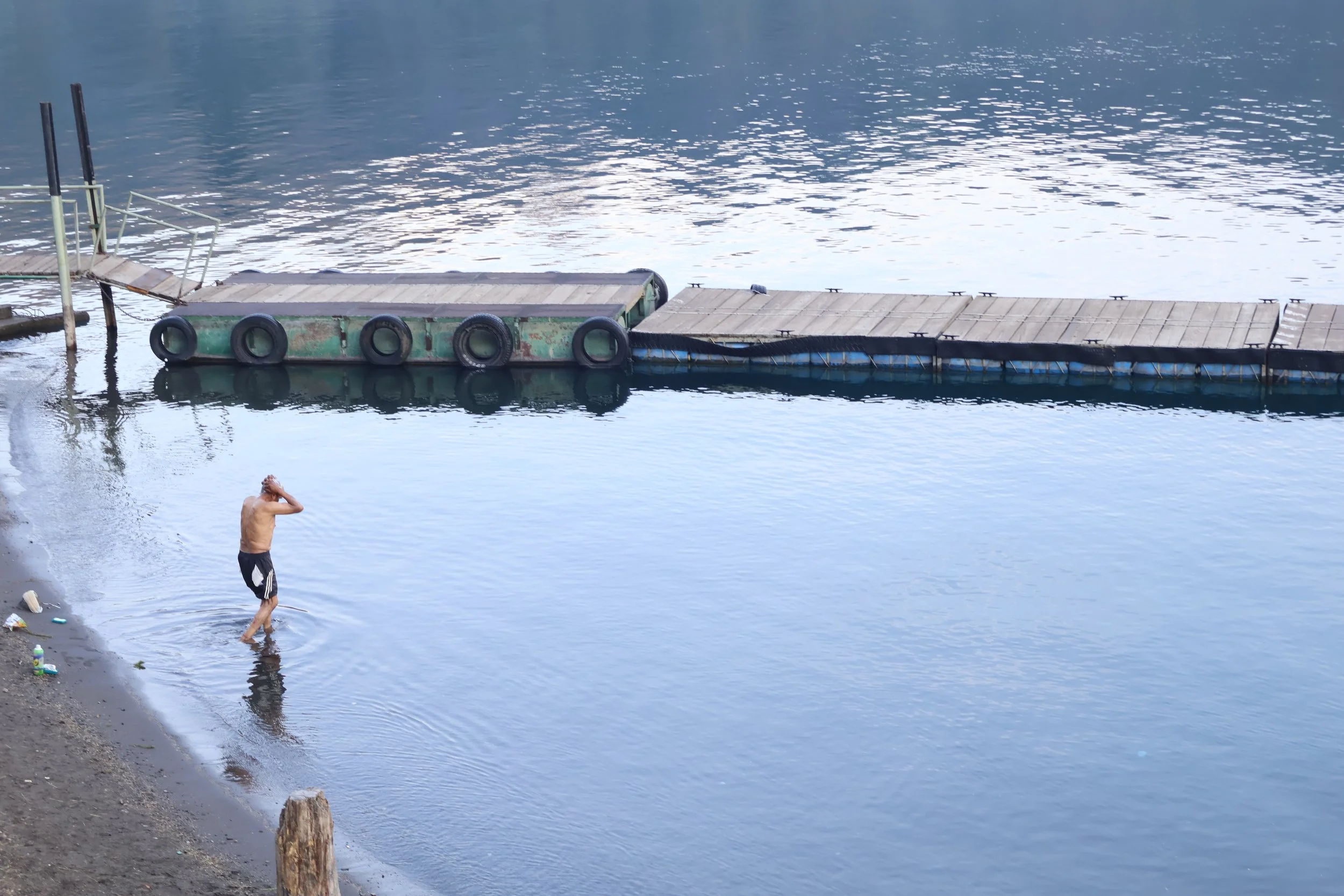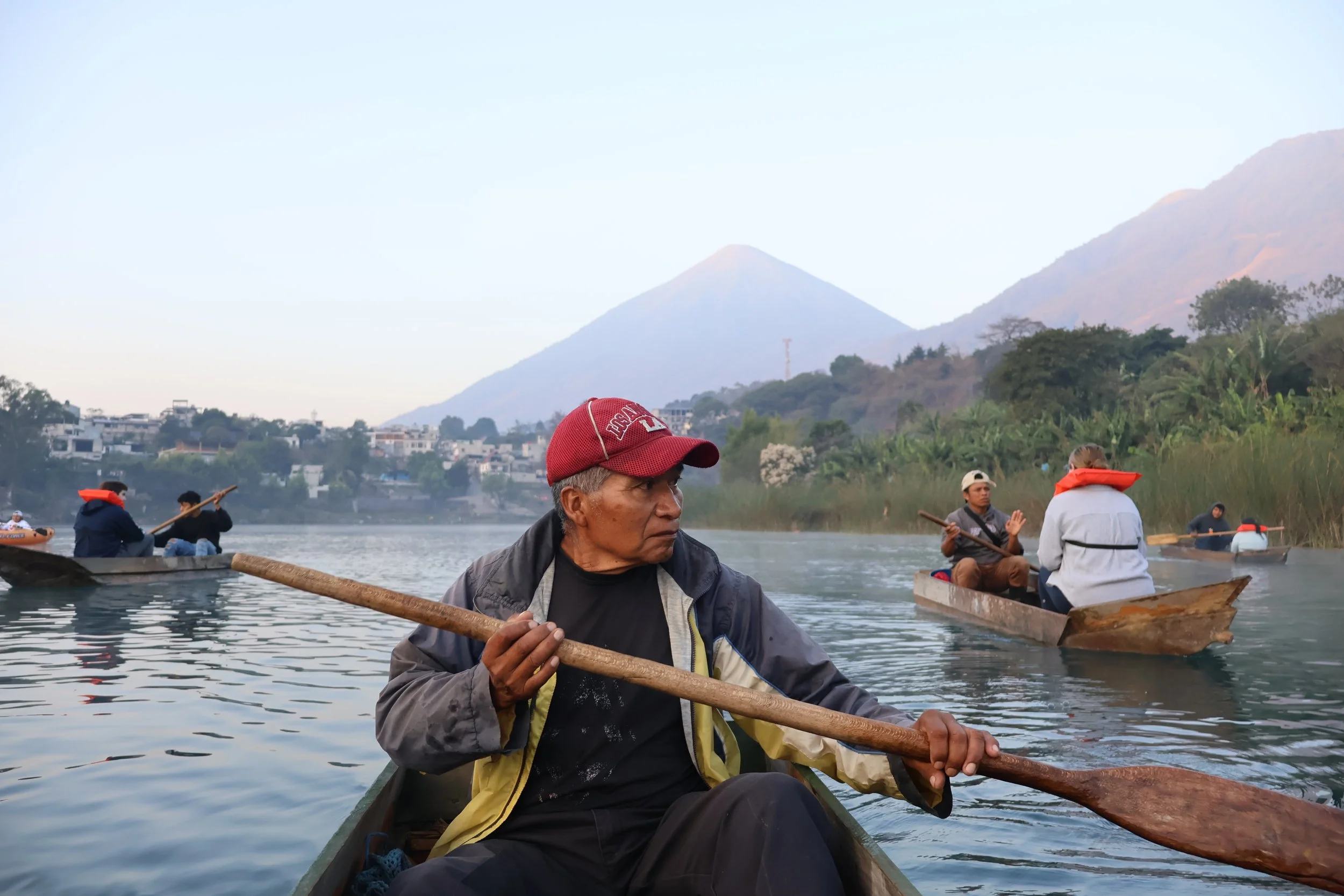Atitlán: “Where the Rainbow Gets Its Colors”
Lake Atitláns historical endurance and struggles for sustainability.
Photos and story by Billy Burke
Lake Atitlán, a crater by creation, formed over 85,000 years ago after a volcano's eruption. Dubbed one of the world's most beautiful lakes, it has become a staple landmark for Guatemala with its commercial fishing and tourism.
A mountain view of Lake Atitlán from San Juan La Laguna.
Indigenous Maya communities surround the lake, including San Pedro La Laguna, San Juan La Laguna, Santiago Atitlán, and San Lucas Toliman. The Kaqchikel and Tz'utujil people that inhabit the region have used fishing in the lake as a source of livelihood for hundreds of years.
Artisanal fishing, a traditional practice, is carried out from the lake's shore by women and children or by boat by the men. This unique division of labor reflects the community's deep connection with the lake and its resources.
The boats, known as "cayucos," are native to Lake Atitlán. They don't use engines, measure 3 to 4 meters long, and are a piece of the region's ancestral craftsmanship.
At the break of dawn, the tranquil waters of Lake Atitlán come alive with the sound of fishermen setting out in their cayucos. This age-old practice, developed by the communities of Lake Atitlán, is not just a way of life but a lifeline for many families. Fishing, which provides both income and food, is deeply ingrained in the cultural and economic fabric of the region.
While fishing as a sole source of income and food has almost entirely vanished because of environmental issues, the Kaqchikel and Tz'utujil continue to fish as they have rights to access fishing as a resource. What is now known and passed down through oral tradition is that there was said to be an intrinsic connection between humans and nature. In Indigenous Maya culture, this was respected, showing that inhabitants considered all living beings sacred and believed they should be treated responsibly.
To preserve these traditions, the Dirección de Normatividad de la Pesca y Acuicultura (DIPESCA) issues fishing permits/licenses in the municipalities of Santiago Atitlán and San Juan La Laguna. In doing so, DIPSESCA acknowledges that the Indigenous Mayas in the respective communities have legal rights to fish based on their cultural connection to the lake.
Most other regional municipalities do not require fishing licenses or permits in the lake. While permits are not widespread, official parameters have been set in place that have banned trammel fishing nets (a method of catching an excessive amount) and fishing for female fish.
Despite the regulations for the region, fishermen have noticed a decrease in the abundance of fish in the lake.
For years, Lake Atitlán has been troubled by environmental challenges that have made it unsafe to drink and swim in.
In 1958, the government introduced the non-native and invasive black bass to the lake in an effort to improve tourism in the area. The government hoped that the surrounding restaurants would attract more tourists to the area with a new type of fresh fish to eat from the lake.
This inadvertently started a chain reaction of devastating consequences. The dominant invasive bass ate through the local food chain, decimating the crab, fish, and plankton populations. This eventually drove the rare Pato Poc duck to extinction by reducing its food supply. The black bass's disruption to Lake Atitlán's ecosystem was unfavorable for almost everything except the bacteria, which it didn't eat.
Since 2009, Lake Atitlán has been declared a contaminated water source due to the bacteria in the water. The thick cyanobacteria attacks the lake in large quantities when it blooms and produces a foul odor when it dies. The murky algae-looking bacteria, although not toxic, consume the lake's oxygen, depriving the fish, crab and other aquatic animals of life.
Likewise, due to the lack of proper wastewater management infrastructure, untreated gray and blackwater from the surrounding communities channel directly into the lake. The absence of adequate sewage treatment not only poses a health risk to the Indigenous locals who use the lake for bathing, washing clothes and drinking but also harms the aquatic life in the ecosystem.
A man is seen bathing on the shore of Lake Atitlán.
In mid-March 2024, a group of students from the United States set out on a guided tour of the lake one morning, led by local native fishermen of the region.
Manuel Xp-Ajcalon (shep-ackalone) is an Indigenous Maya Kaqchikel native to the southwestern highlands who earns a living partly from Lake Atitlán.
Short and stern in his demeanor, Manuel, a man in his mid-50s, does not seem amused by our presence and undoubtedly only agreed to the boat tour for the extra quetzales.
Manuel Xp-Ajcalon, an Indigenous Maya Kaqchikel, has been fishing in Lake Atitlán for nearly 30 years.
After I shook Manuel’s calloused hand, he helped me onto his cayuco and pushed us off into the water at a moment’s notice.
Sitting low and slender in the water, the cayuco cut through the water with ease as if a sculling missile. The small boat looks like it could capsize with an intense sneeze. Each motion made in the cayuco is visible, as though it were an external muscle of the boat’s patron. Manuel is quiet during our time on the lake, observing other fishermen and the environment around us, making little eye contact other than to answer brief questions.
It is a serene and unbothered morning, and the birds’ sunrise songs complement the waning sweeps of water that Manuel draws with every paddle.
Manuel paddling through Lake Atitlán with birds singing in the background.
Continuing our tour, Manuel only circles a small section as the lake is too large to traverse in a boat as small as a cayuco. Despite this, in our short tour, I was able to see some of the murky algae-looking bacteria that have been plaguing the lake for years now.
By the time the cayuco returns to shore, the sun has already broken through the mountaintops and is beginning to shine onto the lake, illuminating the daybreak.
Stepping off the boat, Manuel expertly guides his aged cayuco to join the others on the muddy beach, a testament to his years of experience on these waters.
Now finished, we indolently stand on the beach as the birds’ songs continue.
Manuel has been fishing on Lake Atitlán for nearly 30 years, earning income and providing food for his family.
But in this time, Manuel has seen the decline of fishermen and fish in the lake. Years ago, when the fish population was stable and healthy, fishermen were able to rely on fishing as a sole source of food and income.
Now, most fishermen rely on multiple income sources, including Manuel, who only fishes in the mornings.
"I have been fishing full-time, but I am also a farmer in the mountains,” he says. “I sometimes work with the land. First, when I was a kid, I was a fisherman, and then I started looking for other jobs."
Manuel says that as the years have gone by, the number of fish in the lake has become increasingly scant compared to the decades prior.
"Because the conditions are scarce, the quantity of fish are low,” he says. “I only catch 6 to 7 pounds of fish per day, [while] back in the day, I mostly catch carp fish and I was likely catching 8 to 10 pounds per day."
When discussing the lake's environmental challenges, Manuel's fixed face creases and short answers presented no sentiment to the problems of the lake.
"Yes, I am concerned, but if the fish disappear, I'll still need to look for other ways to work," he says.
Understandably, Manuel is more worried about his own survival than the conditions of the lake. Although the region surrounding Lake Atitlán is a major tourist attraction, it is one of the poorest in Guatemala.
In our conversation, when asked about fishing laws and regulations to protect the lake's ecology, Manuel did not mention DIPSESCA, the licenses they give out to indigenous Mayas, or the rules for the region prohibiting trammel net fishing and fishing for females.
"No, there are no laws or anything telling us how much we can fish,” he says. “You can fish as much as you want [on the lake]."
As we spoke, other fishermen were getting paid for the morning boat tour, and Manuel was standing anxiously the whole time, wanting to go over. He finally does at this point.
Seconds later, he meanders back over after receiving his payment.
Manuel seemed indifferent about the lake's conditions, only ever knowing it as a source of fish and not thinking about the ecological problems. Nonetheless, he was quick to answer when asked what would happen if all the fish suddenly disappeared one day.
"If we run out of fish in the lake, we'll look for other jobs,” he says. “We'll find something else to do, to work."
As stern and bothered by our presence as when we first met, he ends our conversation. Manuel walks off 15 feet to the cayucos and chats with the other fishermen.
Despite Lake Atitlán's hardships and neglect, conservation efforts are being made to protect the lake for future generations.
Many of the lake's pollutants come from improper wastewater management and runoff. In response to the growing problem of wastewater pollution, wastewater treatment plants (WWTP) have been created around Lake Atitlán to treat and effectively manage the wastewater before it is released into the lake.
The construction and operation of these WWTPs have been vital in protecting the water quality and ecosystem of the lake. These treatment plants use various methods to clean the water but only do so partly as monthly maintenance is too expensive, leaving about 80% of sewage untreated to discharge into the lake.
Furthermore, there have been efforts from activists from the surrounding communities to clean piles of garbage along the shores and in the water.
One such group, known as Colectivo Comunidad Tz ‘Unun Ya’ is a group mainly consisting of women who are dedicated to promoting sustainable development and environmental conservation. ‘Unun Ya’ translating to “Work Together”, aims to address the social and ecological challenges facing the region surrounding Lake Atitlán.
In a feature article posted by Waging Nonviolence, it was reported that as much as 3,000 tons of garbage and waste can enter the lake during the rainy season. And throughout
“It is incredible the amount of garbage that makes it into the lake, and local and national authorities do not fulfill their responsibilities,” said Nancy Gonzales, who volunteers with the group, said in the article.
Colectivo Comunidad Tz ‘Unun Ya’ serves as an example of local empowerment, community resilience, and activism in the face of adversity. Through their dedication and passion, the organization has shown that the local Indigenous community has already begun making a positive impact to the sustainable development and conservation of Lake Atitlán, displaying optimism for a cleaner lake in the near future.
Lake Atitlán, a beloved tourist destination, is more than that. It is the lifeblood of the surrounding communities, particularly the Indigenous Mayas like Manuel. They rely on its water for sustenance and livelihood, using it for fishing and drinking. However, the lack of awareness about fishing regulations and the basic necessities of life push locals to the lake, jeopardizing their own future and that of Lake Atitlán.



